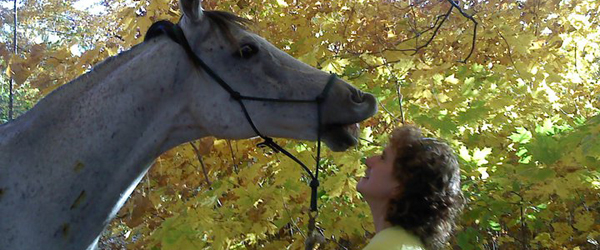 A horse once owned by Dana Isaacson is now being used in mental health therapy after a racing career that included a victory in the Claiming Crown Iron Horse. His name is Superman Can.
A horse once owned by Dana Isaacson is now being used in mental health therapy after a racing career that included a victory in the Claiming Crown Iron Horse. His name is Superman Can.
Local HBPA executive director Patrice Underwood was reminded of that tale recently because she, too, has a horse once raced by Dr. Isaacson.
“My horse is a therapist, too,” she said.
Her substantiation comes directly from her husband, track chaplain Ed Underwood. “I was horseless for several years,” Patrice explained. “When I got Wiley Grey from Dana, Ed told me that I had my High Pro glow back.”
In other words, a missing sheen to her demeanor had returned.
Isaacson, of course, is the founder of the George Bango Dental Clinic on the backside and donates his dental services to the stable-area community. The clinic is named in honor of Isaacson’s trainer, who handled Superman Can.
Wiley Grey, it turns out, probably fits the definition of “student” more accurately than he does “therapist,” because he’s always learning new things and enjoys doing so.
Patrice knew she had a cerebral one shortly after they first met.
Originally, she bought the horse intending to sell him but those plans changed quickly. “He was a pretty dappled gray,” she said. “But then I began playing with him and realized how smart he is.”
She got her first clues shortly after acquiring Wiley seven years ago. “Someone had a round pen back by the pool,” she explained. “When I’d walk away from him, he’d follow me. If I stopped, he’d stop. If I turned, he turned around with me.”
Wiley Grey is learning to speak “human.”
“If I ask him to show me his tattoo, he’ll lift his lip and his head so I can see it,” Patrice said. Wiley also enjoys a bit of recreation now and then. He’ll push his very large ball around the arena, even run it up a wall.
This former racehorse was not overly impressive on the racetrack, but part of the reason is now quite clear.
He had mystery lameness. “Sometimes it looks like he is off on the right front, other times it appears in his behind,” Patrice said. “It just changes.”
Wiley had “kissing spines” that would affect his movement depending where they pressed on the vertebrae. So, he can’t jump or do hill climbing, but he is perfectly fine for trail riding, or learning new things in the arena. His feet were another concern at one time. He wore two different shoe sizes, but now gets along just fine shoeless.
“He’s very bright and he learns quickly,” Patrice added. He continues learning, right along with his rider.
Patrice uses “natural horsemanship” on Wiley. She uses a rope halter when she rides him, occasionally bareback. “I’ve put a bit in his mouth only four or five times in the time I’ve owned him,” she said.
She still resorts to more traditional methods on the trail, however.
In a nutshell, natural horsemanship is a technique that has horse respond to your body and inclination atop him. The horse feels and responds to the energy and body language of the rider.
Thus, Wiley will stop when he feels Patrice completely relax. He’ll turn in the direction her body turns, or he will pick it up when her body sends a corresponding message.
These techniques are perhaps illustrated at their best by a master of the technique like Pat Parelli or Stacy Westfall (video below), who won a national reining competition without saddle or bridle.
[youtube http://www.youtube.com/watch?v=a-7v8Ck1crg?rel=0]
Wiley, for the record, had 49 starts with two wins, four seconds and nine thirds for earnings of $52,802. He is by Ferrara from Timely Impression, was foaled in 1999 and raced from his two-year old season through June of 2004.
Underwood pointed out that Man O’ War is included on his papers, “six generations back.”
There is more to the Parelli method of handling horses with kindness, touching and gentle stroking. There is also the matter of desensitizing them, teaching them that any number of elements are not monsters bent on their destruction.
Underwood can pull a tarp over Wiley’s back and head without disturbing him in the least. A plastic bag on the road won’t annoy or frighten him. “Nothing seems to bother him,” she said.
The Parelli method gets additional support from Hall of Fame rider Julie Krone. “She was interviewed about it in a Thoroughbred Times article in 2003,” Underwood continued. “She spent some time at Pat Parelli’s ranch and said that she wished she’d known all of this stuff before she was at the racetrack.”
There is evidence that horses respond better to gentle attention than to rough handling. “A horse can feel a fly before it lands on him,” Underwood added. “Horses are more sensitive than we imagine. If you pet a horse’s neck and can hear it, you’re petting too hard.”
There is more to the Wiley Grey story, a lot more. For instance, he was lost for five days in the northern Minnesota woods at one time and was dehydrated when found. Patrice was thinking perhaps the worst when his hoofprints were discovered before he was, and they were followed by those of a wolf.
That tale will have to await another day, another occasion, because the 2012 race meet has come to an end.
This blog was written by Canterbury Staff Writer Jim Wells. Wells was a longtime sportswriter at the Pioneer Press and is a member of the Canterbury Park Hall of Fame.